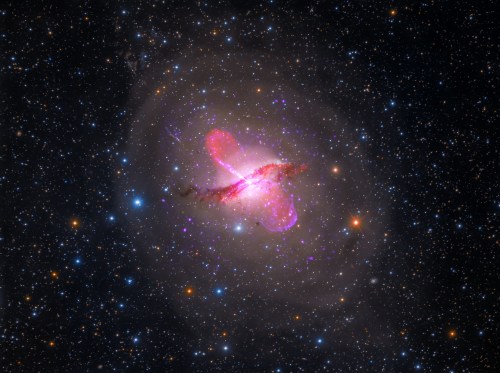
When the James Webb Space Telescope launches later this year, it’ll be the most complex space observatory in the world. Now, NASA has shared a glimpse into the kind of work that it will be able to perform in a profile of research that will be conducted on the nearby galaxy Centaurus A.
The galaxy Centaurus A is enormous and very active, with a warped central disk that was twisted out of shape when it collided with another galaxy. And its center is even more intriguing, as its supermassive black hole is spewing out jets of material with such energy that they travel beyond the bounds of the galaxy itself.
It’s this active galactic nucleus that scientists want to observe in more detail. But to do that, they need to look through the dust around the core to see the central region in more detail. That’s what the upcoming James Webb telescope will be able to do.
“There’s so much going on in Centaurus A,” explained Nora Lützgendorf, the lead researcher of the team which will study this galaxy, in a statement. “The galaxy’s gas, disk, and stars all move under the influence of its central supermassive black hole. Since the galaxy is so close to us, we’ll be able to use Webb to create two-dimensional maps to see how the gas and stars move in its central region, how they are influenced by the jets from its active galactic nucleus, and ultimately better characterize the mass of its black hole.”
To understand complex, active areas like galactic nuclei, it helps to look at them in different parts of the electromagnetic spectrum, such as X-ray and radio. Different wavelengths can detect different features, so looking across a range of wavelengths builds up a more complete picture. Webb’s infrared instruments, for example, can look through clouds of dust to see what lies beneath.
“Multi-wavelength studies of any galaxy are like the layers of an onion,” said fellow lead researcher Macarena García Marín. “Each wavelength shows you something different. With Webb’s near- and mid-infrared instruments, we’ll see far colder gas and dust than in previous observations, and learn much more about the environment at the center of the galaxy.”
Webb will be able to take not only images of this region, but also use an instrument called a spectrograph to find out the composition of the material as well. “When it comes to spectral analysis, we conduct many comparisons,” Marín said. “If I compare two spectra in this region, maybe I will find that what was observed contains a prominent population of young stars. Or confirm which areas are both dusty and heated. Or maybe we will identify emission coming from the active galactic nucleus.”
The researchers plan to create a map of this busy region, and from this map, they’ll be able to see how the gravity of the supermassive black hole affects material around it. From this, they’ll be able to more accurately pin down the black hole’s mass.
And this could be just the beginning of the discoveries. “The most exciting aspect about these observations is the potential for new discoveries,” Marín said. “I think we might find something that makes us look back to other data and reinterpret what was seen earlier.”
Editors' Recommendations
- James Webb observes extremely hot exoplanet with 5,000 mph winds
- Biggest stellar black hole to date discovered in our galaxy
- Stunning image shows the magnetic fields of our galaxy’s supermassive black hole
- Nightmare black hole is the brightest object in the universe
- See 19 gorgeous face-on spiral galaxies in new James Webb data